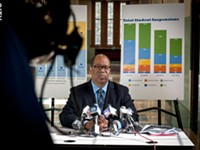Friday, August 2, 2013
Charters show higher suspensions
Posted By Tim Louis Macaluso on Fri, Aug 2, 2013 at 12:56 PM
One of the most common characteristics of charter schools with high test scores, many observers say, is the focus on structure and discipline. The schools often bear a striking resemblance to the Catholic schools of the 1950’s and ‘60’s, with their low tolerance for levity and horseplay. The charters like to call it "no excuses."
Back in the day, in my small elementary school run by the Sisters of St. Joseph, a swift knuckle rapping with a wooden yardstick for talking out of turn wasn't uncommon. Students were seldom sent to the principal’s office. Discipline was delivered instantly before God and everyone. Public humiliation had its place.
But those options don’t exist in contemporary public schools, including charters. However, suspensions do. And a new report by the New York Civil Liberties Union not only exposes the high number of suspensions per school year that have occurred in New York City’s charter schools compared to traditional public schools, but it also indicates a correlation exists between high-performing charters and higher-than-average suspensions.
Data collected over the last decade involving New York City’s charter schools showed that the schools developed their own discipline codes. And suspensions typically exceeded the city’s 7.5 percent suspension rate in traditional public schools.
“Two Brooklyn Collegiate Charter Schools in the Uncommon Schools network suspend students at 35 and 40 percent rates,” according to the report. This is not to say that suspensions don’t occur in traditional public schools. The Rochester school district was suspending as many as 11,000 of its students several years ago.
Many charter school advocates routinely say that they don’t cherry-pick students, and that they accept all students, including those with high needs. But critics dispute those claims.
Putting the suspensions aside for a moment, charters were sold as incubators of new ideas for improving student outcomes -- innovations that could be developed and shared with traditional public schools. But increasingly they’re touted as the competition, which is something entirely different.
And we may want to be cautious about making policy decisions based on inaccurate comparisons resulting from this grand contest.
Speaking of...
Latest in News Blog
More by Tim Louis Macaluso
-

RCSD financial crisis builds
Sep 23, 2019 -

RCSD facing spending concerns
Sep 20, 2019 -

Education forum tomorrow night for downtown residents
Sep 17, 2019 - More »




